How to Make Tomato Vinegar
Tomato vinegar is made via a two-part fermentation process. First, yeasts consume sugars to produce alcohol, known as alcoholic fermentation.
Second, acetic acid bacteria consume the alcohol from step one and convert it into acetic acid. Once all the alcohol is metabolized by bacteria and converted into acetic acid, you have vinegar.
To make tomato vinegar at home, you first make something like wild tomato wine, which then turns into vinegar!

How to Make Vinegar from Cherry Tomatoes
It is so easy to make vinegar with ripe cherry tomatoes. You only need a few ingredients: fresh cherry tomatoes, sugar, raw vinegar (as a starter culture), and water.
It helps if you have some raw apple cider vinegar (or any raw vinegar) with the mother as a starter, but it is not 100% necessary. Though, I highly recommend it.
I also want to talk about tomatoes for a minute. You can use any tomatoes for this recipe, but I like heirloom, homegrown cherry tomatoes the best. I also left a few of the green tops on as a source of wild microbes. Plant green matter with folds and pores holds more microbes than the smooth skin of washed tomatoes.
If you are concerned about the green bits of tomatoes having more harmful nightshade compounds, there’s some significant research out there about microbial degradation of tomatine and other steroid glycoalkaloids during fermentation. In other words, the microbes break down the compounds that may be harmful. If you’re interested in reading more about this, visit Google Scholar and type in the search bar “steroid glycoalkaloid degradation in fermentation.”
Side note, if you really love tomatoes, listen to the song “homegrown tomatoes” while making this recipe. It’s a certified hit, lol.
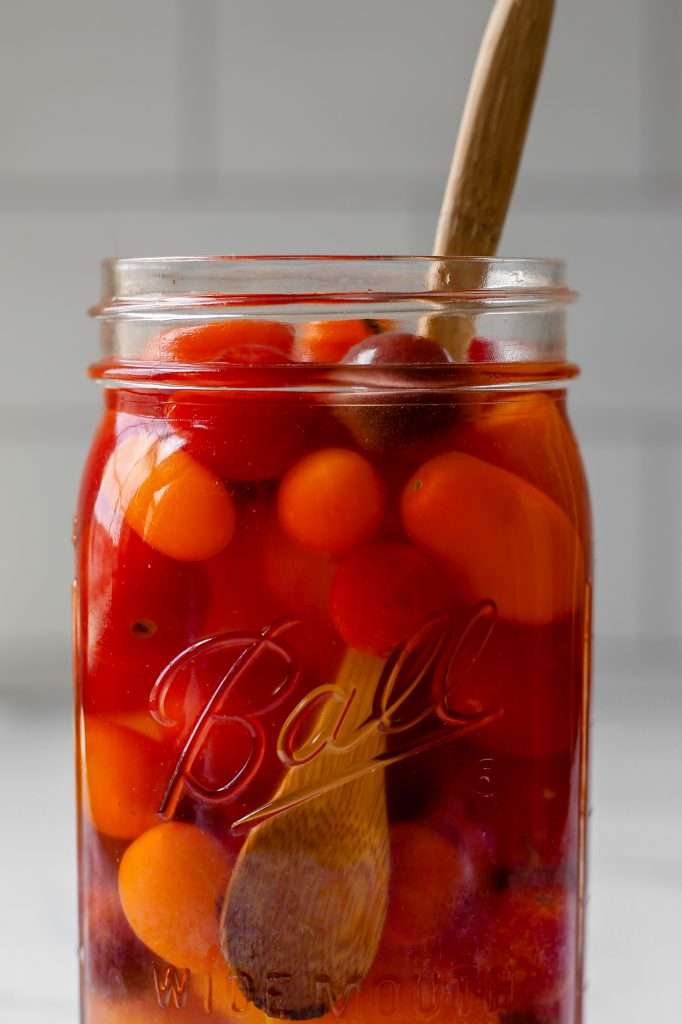
What is a Vinegar Mother?
Vinegar “with the mother” is another name for raw vinegar containing all the microbes from the brewing process. So, think of the mother as microbial cultures. Vinegar mothers form cloudy floating pieces within the vinegar and a SCOBY on the surface.
A vinegar mother SCOBY looks similar to a kombucha SCOBY but is often lighter with varying textures. Vinegar mothers in homemade vinegar are always unique. No two will look the same because the wild microbes from fruit scraps will differ slightly across batches. If it’s not chalky or fuzzy, it’s probably a perfectly ordinary mother.
You can use the vinegar mother SCOBY from your first batch of vinegar to culture the next batch of vinegar.
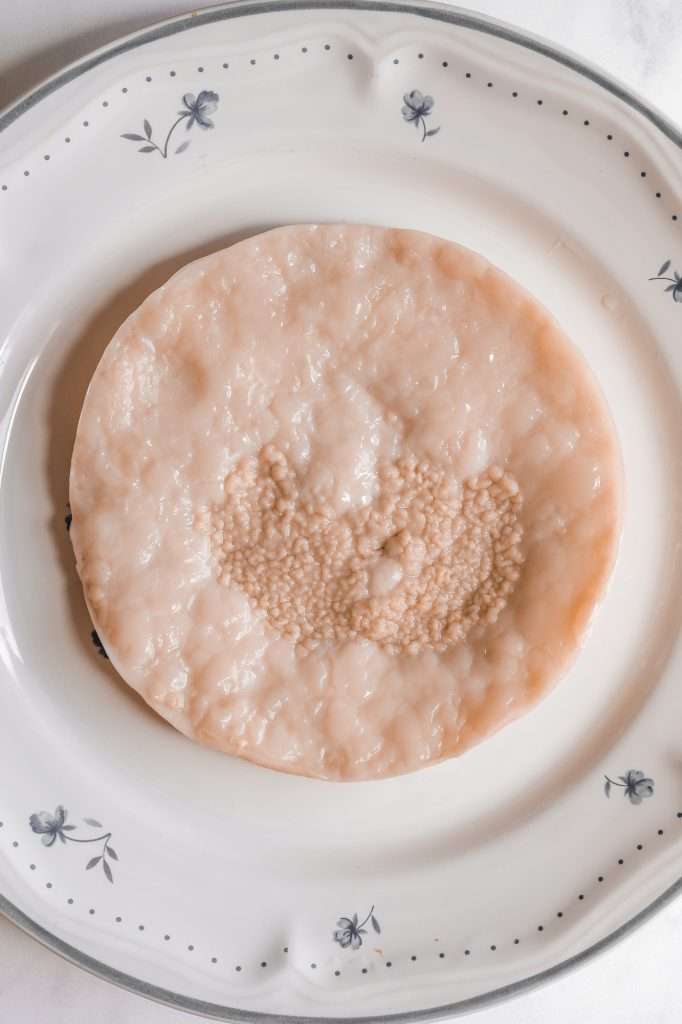
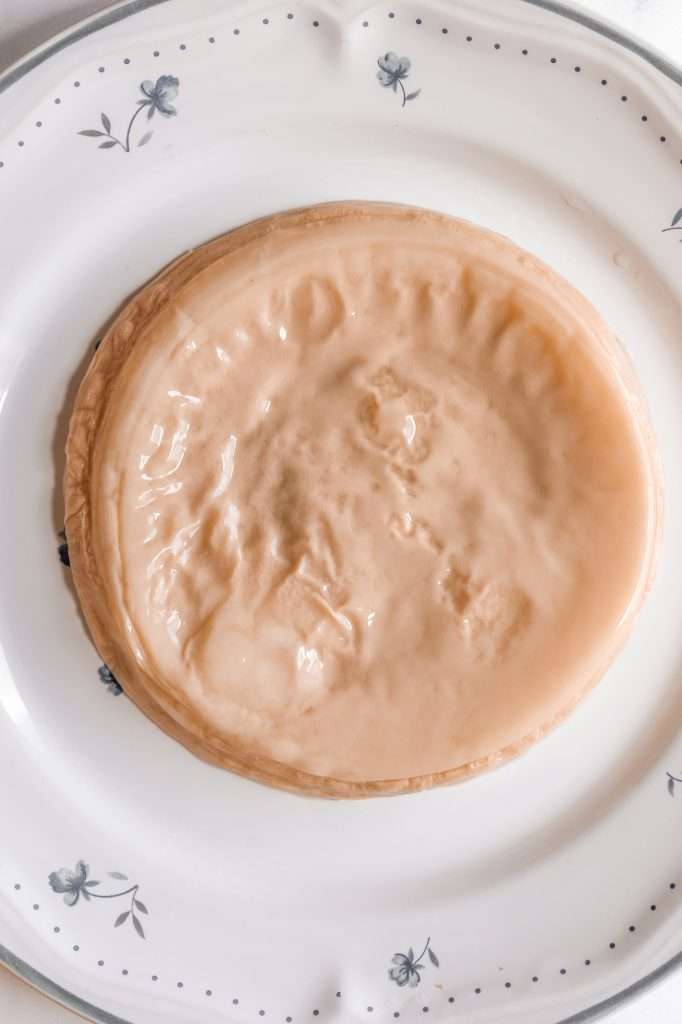
Equipment for Tomato Vinegar Fermentation
I suggest a 32-ounce (1-quart) glass mason jar and a cloth cover with a rubber band for this recipe.
You must use a cloth lid when making vinegar because acetic acid bacteria require oxygen to convert alcohol into acetic acid. I usually make cloth lids for fermentation by cutting up old t-shirts.
Here is all the equipment you need:
- 1-quart mason jar
- a cloth lid and a rubber band
- a kitchen scale
- large spoon (for stirring daily)
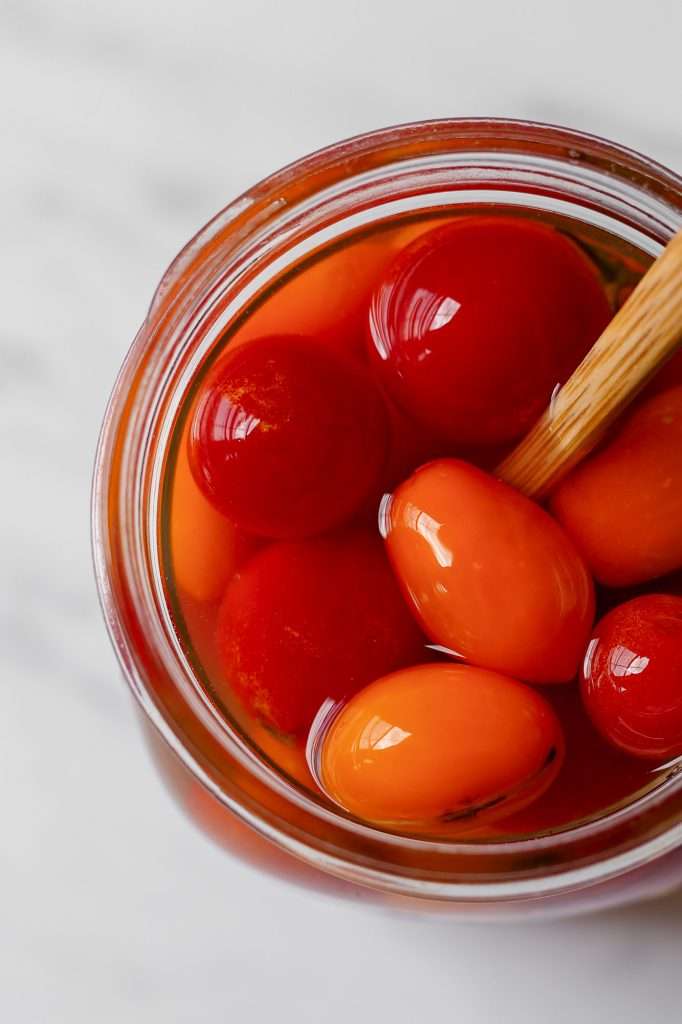

What Do You Use Tomato Vinegar For?
I use my homemade tomato vinegar in any recipe where I would use store-bought apple cider vinegar. It does impart a hint of tomato where you use it, so I suggest using it with savory recipes.
Tomato vinegar may or may not be adequate for pickling and canning pickles. It depends on the sugar content of the cherry tomatoes. To make a strongly acidic vinegar, use more sugar and very ripe tomatoes. You can also add in some sulfite-free wine, tequila, or vodka in place of some of the water.
You can also test the pH with a pH strip to see if it is good for pickling/canning. Vinegar that is safe for pickling recipes should have approximately 2.4 pH (about 5% acidity).
Here are my favorite ways to use homemade vinegar:
- for homemade salad dressing
- in heirloom culturing recipes like this fermented green tomato recipe
- In braising recipes like Tomato Braised Kale and Chickpeas with Chard
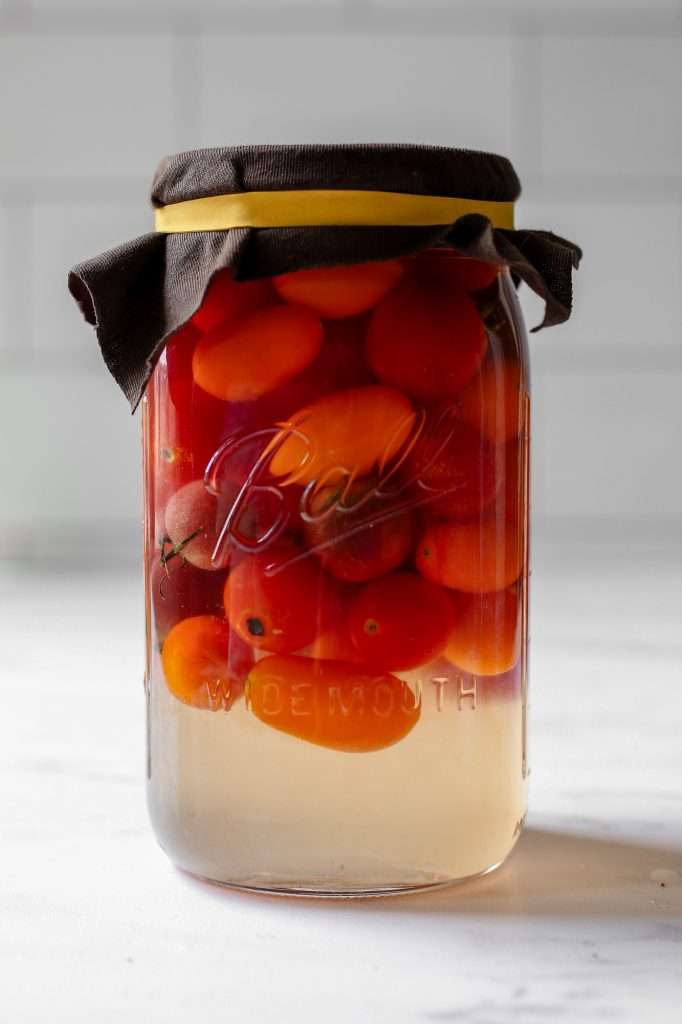
Homemade Tomato Vinegar
The keys to remember when making tomato vinegar or any fruit vinegar at home:
- Stir the vinegar once daily. Remove the cloth lid, give it a good stir, replace the lid, and repeat daily until you strain the vinegar.
- You must use a breathable cloth lid. The microbes involved in vinegar production require oxygen to convert alcohol to acetic acid.
- Use a clean glass container. It is best to use glass when fermenting acidic vinegar. Clean your equipment well before getting started.
What should you do with the spent tomatoes? I like to pop them in my dehydrator and turn them into tomato powder. Makes an excellent seasoning for eggs and stews.
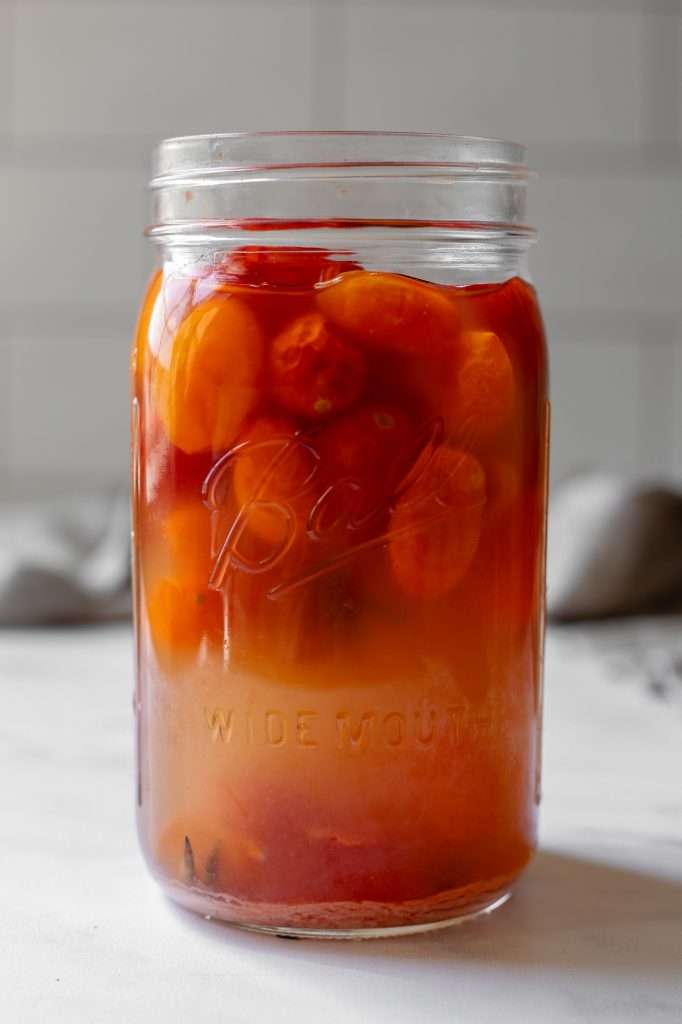

Homemade Tomato Vinegar Made With Heirloom Cherry Tomatoes
My easy tomato vinegar recipe requires only four ingredients: tomatoes, sugar, raw vinegar for a starter culture, and water. This is the perfect recipe to use up extra tomatoes in the summer. I like to use cherry tomatoes, but you can use any kind of tomato in this recipe.
- Prep: 10 minutes
- Total Time: 1512 hours 10 minutes
Ingredients
- 3 cups cherry tomatoes
- 56 grams of organic cane sugar
- Water
- 3 tablespoons raw apple cider vinegar with the mother
- 32 ounce glass jar
- cloth covering
- rubber band
Instructions
- Please read the recipe notes.
- Add the sugar and tomatoes to a 1-quart glass jar.
- Add water to the jar until full.
- Add in a few tablespoons of raw apple cider vinegar with the mother. This helps establish a good microbial community, and while it isn’t absolutely necessary to add, I highly recommend it. If you’ve made vinegar before and have a vinegar mother, you can add it.
- Stir (or shake) the mixture until all the sugar is dissolved.
- Place a cloth lid on the jar and secure it with a rubber band.
- Stir the mixture once or twice a day and allow to ferment at room temperature for three weeks. Don’t forget to stir it. I like to do it first thing in the morning each day.
- You should notice the mixture bubble within one week.
- After three weeks of fermentation, strain out all the tomato pieces, replace the cloth lid, and allow the mixture to ferment for 6 more weeks. (no need to stir anymore after it is strained)
- You will notice a vinegar mother form on the surface (it looks like a kombucha SCOBY but is very light in color). You can keep this to start your next batch of vinegar.
- After fermentation, bottle the vinegar and seal it with a solid lid. Store at room temperature in your pantry.
Notes
- Vinegar works best with a starter culture. While it is possible to make vinegar without it, adding a vinegar mother or raw apple cider vinegar with the mother to the mixture ensures success. If you have a kombucha SCOBY or raw kombucha, you can sub for that with good results.
- For very strong vinegar, you can add in some sulfite-free wine, tequila, or vodka in place of some of the water.
- For stronger vinegar, you can also add about 1/2 a teaspoon of packaged cider yeast to the mixture.















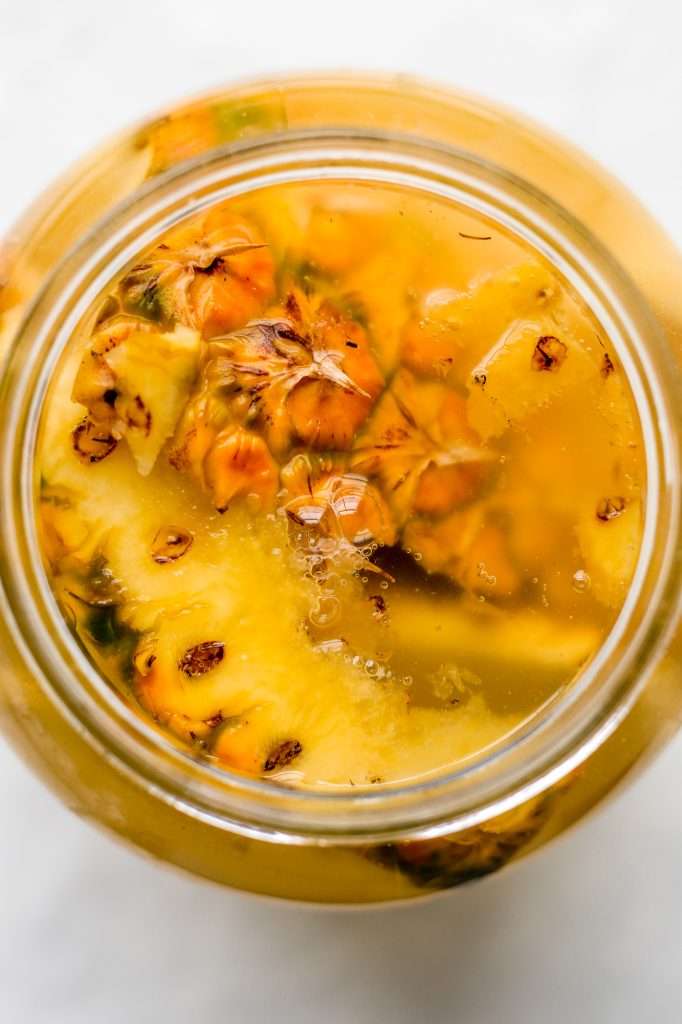
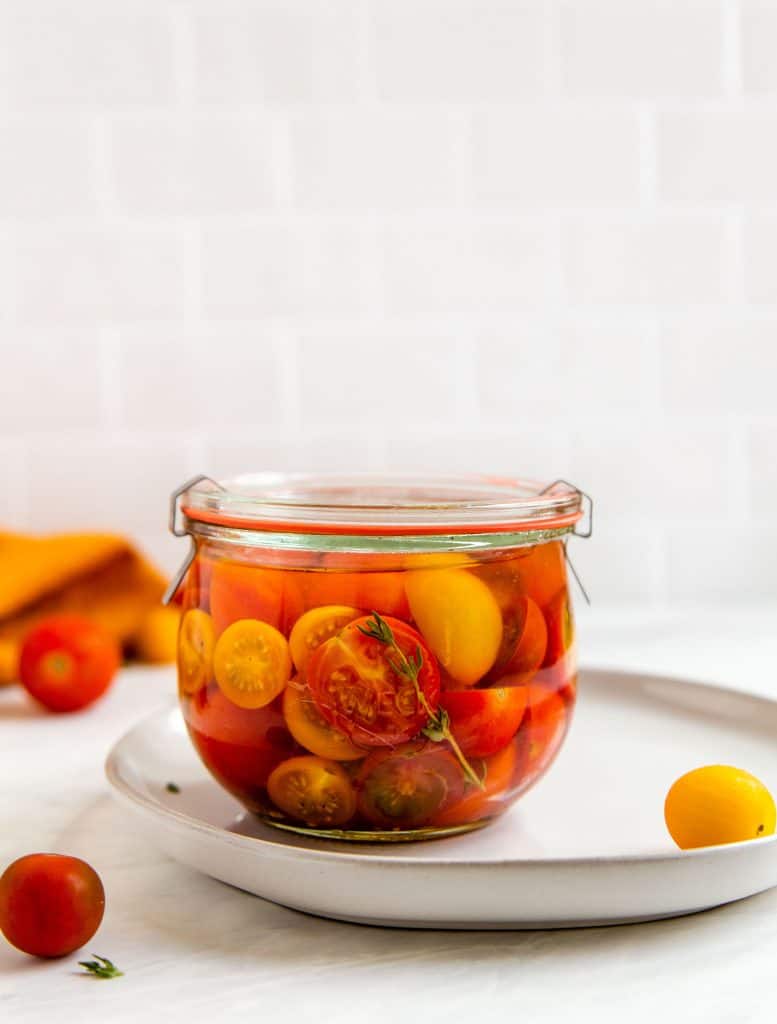



I think there is a typo “I suggest a 3-ounce (1-quart) glass mason jar and a cloth cover with a rubber band for this recipe.” Assuming it is 32, not 3 ounces. We made this but it’s too early to know how it’s turned out since we just made it yesterday,
ah yes, it appears the 2 got left out. thanks for pointing this out!
Why is the sugar concentration much lower than for kombucha vinegar recipe? Do the tomatoes contribute the additional sugar?
Before removing the tomatoes, could I mash them then strain out the skins and seeds but leave in the pulp for more tomato flavor and more viscosity?
The sugar concentration is not lower (by any significant amount) in this recipe than the kombucha vinegar recipe. The kombucha vinegar recipe is written for about a gallon of kombucha vinegar (4000 mL). This one is a one quart recipe. so the sugar concentration is very similar. And yes, the tomatoes are full of fructose, a fermentable sugar.
you can mash everything up before straining.
I’m thinking about trying to add cider yeast on my next batch. At what point in the process should I add it? Thank you!
At the beginning, when you add the raw vinegar.
I have made apple scrap vinegar multiple times following your recipes, with flawless success. I’ve just recently started some tomato vinegar, and there is something that looks like a pellicle forming at the top (I have been stirring every day). It doesn’t look like mold, but I have never seen a pellicle form on my vinegar before, nor have I seen one on ferments only a couple of days old. Should I be concerned?
nope! no need to be concerned, it sounds like that is just a vinegar mother pellicle forming.
What can I do to the tomato pieces after I strain it out from the vinegar?
They may taste kind of yeasty, I usually compost them. But I bet they would be delicious folded into a sourdough bread with some cheese maybe?